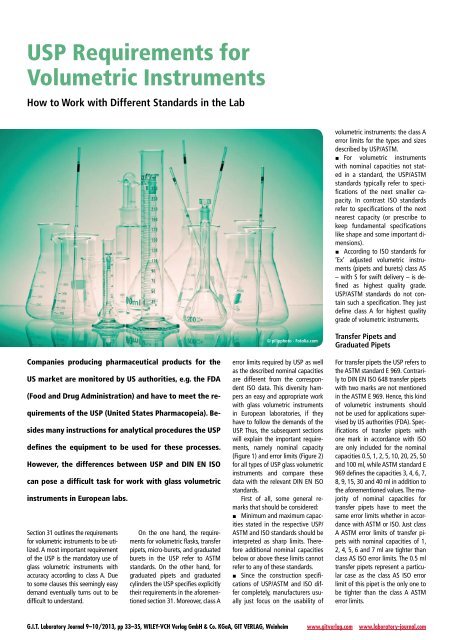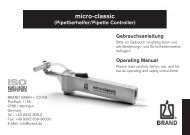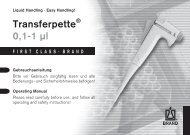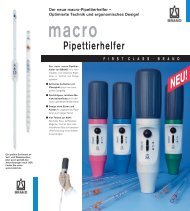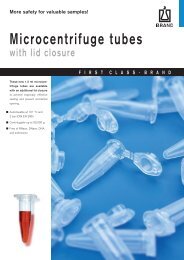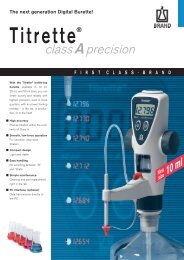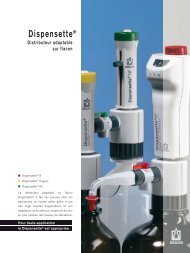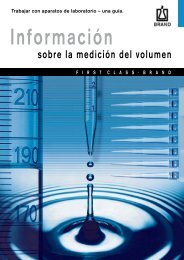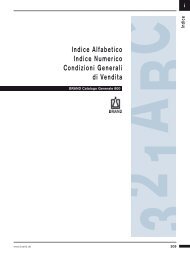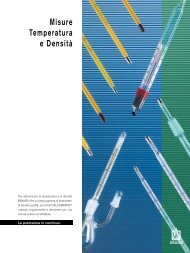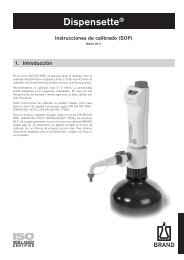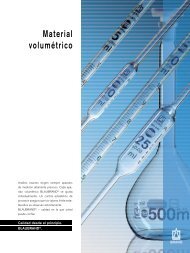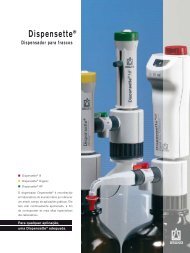USP Requirements for Volumetric Instruments - How to Work ... - Brand
USP Requirements for Volumetric Instruments - How to Work ... - Brand
USP Requirements for Volumetric Instruments - How to Work ... - Brand
You also want an ePaper? Increase the reach of your titles
YUMPU automatically turns print PDFs into web optimized ePapers that Google loves.
<strong>USP</strong> <strong>Requirements</strong> <strong>for</strong><br />
<strong>Volumetric</strong> <strong>Instruments</strong><br />
<strong>How</strong> <strong>to</strong> <strong>Work</strong> with Different Standards in the Lab<br />
volumetric instruments: the class A<br />
error limits <strong>for</strong> the types and sizes<br />
described by <strong>USP</strong>/ASTM.<br />
▪▪<br />
For volumetric instruments<br />
with nominal capacities not stated<br />
in a standard, the <strong>USP</strong>/ASTM<br />
standards typically refer <strong>to</strong> specifications<br />
of the next smaller capacity.<br />
In contrast ISO standards<br />
refer <strong>to</strong> specifications of the next<br />
nearest capacity (or prescribe <strong>to</strong><br />
keep fundamental specifications<br />
like shape and some important dimensions).<br />
▪▪<br />
According <strong>to</strong> ISO standards <strong>for</strong><br />
‘Ex’ adjusted volumetric instruments<br />
(pipets and burets) class AS<br />
– with S <strong>for</strong> swift delivery – is defined<br />
as highest quality grade.<br />
<strong>USP</strong>/ASTM standards do not contain<br />
such a specification. They just<br />
define class A <strong>for</strong> highest quality<br />
grade of volumetric instruments.<br />
Companies producing pharmaceutical products <strong>for</strong> the<br />
US market are moni<strong>to</strong>red by US authorities, e.g. the FDA<br />
(Food and Drug Administration) and have <strong>to</strong> meet the requirements<br />
of the <strong>USP</strong> (United States Pharmacopeia). Besides<br />
many instructions <strong>for</strong> analytical procedures the <strong>USP</strong><br />
defines the equipment <strong>to</strong> be used <strong>for</strong> these processes.<br />
<strong>How</strong>ever, the differences between <strong>USP</strong> and DIN EN ISO<br />
can pose a difficult task <strong>for</strong> work with glass volumetric<br />
instruments in European labs.<br />
Section 31 outlines the requirements<br />
<strong>for</strong> volumetric instruments <strong>to</strong> be utilized.<br />
A most important requirement<br />
of the <strong>USP</strong> is the manda<strong>to</strong>ry use of<br />
glass volumetric instruments with<br />
accuracy according <strong>to</strong> class A. Due<br />
<strong>to</strong> some clauses this seemingly easy<br />
demand eventually turns out <strong>to</strong> be<br />
difficult <strong>to</strong> understand.<br />
On the one hand, the requirements<br />
<strong>for</strong> volumetric flasks, transfer<br />
pipets, micro-burets, and graduated<br />
burets in the <strong>USP</strong> refer <strong>to</strong> ASTM<br />
standards. On the other hand, <strong>for</strong><br />
graduated pipets and graduated<br />
cylinders the <strong>USP</strong> specifies explicitly<br />
their requirements in the a<strong>for</strong>ementioned<br />
section 31. Moreover, class A<br />
© pilippho<strong>to</strong> - Fo<strong>to</strong>lia.com<br />
error limits required by <strong>USP</strong> as well<br />
as the described nominal capacities<br />
are different from the correspondent<br />
ISO data. This diversity hampers<br />
an easy and appropriate work<br />
with glass volumetric instruments<br />
in European labora<strong>to</strong>ries, if they<br />
have <strong>to</strong> follow the demands of the<br />
<strong>USP</strong>. Thus, the subsequent sections<br />
will explain the important requirements,<br />
namely nominal capacity<br />
(Figure 1) and error limits (Figure 2)<br />
<strong>for</strong> all types of <strong>USP</strong> glass volumetric<br />
instruments and compare these<br />
data with the relevant DIN EN ISO<br />
standards.<br />
First of all, some general remarks<br />
that should be considered:<br />
▪▪<br />
Minimum and maximum capacities<br />
stated in the respective <strong>USP</strong>/<br />
ASTM and ISO standards should be<br />
interpreted as sharp limits. There<strong>for</strong>e<br />
additional nominal capacities<br />
below or above these limits cannot<br />
refer <strong>to</strong> any of these standards.<br />
▪▪<br />
Since the construction specifications<br />
of <strong>USP</strong>/ASTM and ISO differ<br />
completely, manufacturers usually<br />
just focus on the usability of<br />
Transfer Pipets and<br />
Graduated Pipets<br />
For transfer pipets the <strong>USP</strong> refers <strong>to</strong><br />
the ASTM standard E 969. Contrarily<br />
<strong>to</strong> DIN EN ISO 648 transfer pipets<br />
with two marks are not mentioned<br />
in the ASTM E 969. Hence, this kind<br />
of volumetric instruments should<br />
not be used <strong>for</strong> applications supervised<br />
by US authorities (FDA). Specifications<br />
of transfer pipets with<br />
one mark in accordance with ISO<br />
are only included <strong>for</strong> the nominal<br />
capacities 0.5, 1, 2, 5, 10, 20, 25, 50<br />
and 100 ml, while ASTM standard E<br />
969 defines the capacities 3, 4, 6, 7,<br />
8, 9, 15, 30 and 40 ml in addition <strong>to</strong><br />
the a<strong>for</strong>ementioned values. The majority<br />
of nominal capacities <strong>for</strong><br />
transfer pipets have <strong>to</strong> meet the<br />
same error limits whether in accordance<br />
with ASTM or ISO. Just class<br />
A ASTM error limits of transfer pipets<br />
with nominal capacities of 1,<br />
2, 4, 5, 6 and 7 ml are tighter than<br />
class AS ISO error limits. The 0.5 ml<br />
transfer pipets represent a particular<br />
case as the class AS ISO error<br />
limit of this pipet is the only one <strong>to</strong><br />
be tighter than the class A ASTM<br />
error limits.<br />
G.I.T. Labora<strong>to</strong>ry Journal 9–10/2013, pp 33–35, WILEY-VCH Verlag GmbH & Co. KGaA, GIT VERLAG, Weinheim<br />
www.gitverlag.com www.labora<strong>to</strong>ry-journal.com
The <strong>USP</strong> defines the specifications<br />
<strong>for</strong> graduated pipets with<br />
nominal capacities 1, 2, 5, and 10<br />
ml as well as the respective class A<br />
error limits directly in the section<br />
31. In contrast <strong>to</strong> the DIN EN ISO<br />
835 just type 2 graduated pipets<br />
are mentioned. As a consequence<br />
the commonly known types 1 and<br />
3 pipets should not be used <strong>for</strong> applications<br />
supervised by US authorities.<br />
Class A <strong>USP</strong> error limits of the<br />
5 and 10 ml graduated pipets are<br />
tighter than class AS error limits of<br />
the correlated ISO standard, while<br />
the 2 ml graduated pipet exhibits<br />
the same error limit with reference<br />
<strong>to</strong> both standards. The 1 ml graduated<br />
pipet represents another particular<br />
case as the class AS ISO error<br />
limit of this pipet is tighter than<br />
the class A <strong>USP</strong> error limit.<br />
Flasks, Cylinders, Burets<br />
For volumetric flasks the <strong>USP</strong> refers<br />
<strong>to</strong> ASTM standard E 288, which does<br />
Fig. 1: Comparison of minimal (left) and maximal nominal capacities (right)<br />
defined by <strong>USP</strong>/ASTM and ISO<br />
not state nominal capacities below<br />
5 ml and above 2000 ml. Hence, the<br />
commonly known 1 and 2 ml trapezoidal<br />
flasks and the 5000 ml bulbshaped<br />
flasks should not be used <strong>for</strong><br />
applications supervised by US authorities.<br />
The <strong>USP</strong> refers <strong>to</strong> the ASTM<br />
standard E 288, which describes<br />
tighter class A error limits than the<br />
comparable DIN EN ISO 1042 <strong>for</strong> all<br />
sizes of volumetric flasks.<br />
Specifications <strong>for</strong> graduated<br />
cylinders are mentioned in section<br />
31 of the <strong>USP</strong>. In comparison with<br />
the respective DIN EN ISO 4788 4<br />
sizes, namely the capacities 5, 10,<br />
100, and 250 ml, show the same<br />
error limits. Class A error limits of<br />
the other 5 nominal capacities (25,<br />
50, 500, 1000, and 2000 ml) defined<br />
by <strong>USP</strong> are tighter than the<br />
corresponding limits of the ISO<br />
standard. Please note that class A<br />
error limits <strong>for</strong> mixing cylinders are<br />
the same as <strong>for</strong> graduated cylinders<br />
regardless whether they are<br />
with reference <strong>to</strong> <strong>USP</strong> or ISO.<br />
For burets the <strong>USP</strong> refers <strong>to</strong><br />
ASTM standards E 287 <strong>for</strong> graduated<br />
burets (nominal capacities from<br />
10 <strong>to</strong> 100 ml) and E 1189 <strong>for</strong> microburets<br />
(nominal capacities from 1 <strong>to</strong><br />
10 ml) while the respective DIN EN<br />
ISO standard 385 describes specifications<br />
<strong>for</strong> nominal capacities from<br />
1 <strong>to</strong> 100 ml. Class A error limits of<br />
<strong>USP</strong>/ASTM are the same as the<br />
class AS error limits of ISO. <strong>How</strong>ever,<br />
they may differ with regard <strong>to</strong> the<br />
commonly known 25 ml buret,<br />
which is not described by <strong>USP</strong>/<br />
Fig. 2: Error limits of highest quality grade volumetric instruments in accordance with <strong>USP</strong>/ASTM (class A) or ISO (class A or AS): a) transfer pipets: Capacities<br />
3, 4, 6, 7, 8, 9, 15, 30 and 40 ml are not stated in ISO; b) graduated pipets; c) volumetric flasks: Capacity 20 ml is not stated in <strong>USP</strong>/ASTM; d) graduated cylinders.<br />
Please note general remark 3 <strong>for</strong> capacities not stated in a standard.
ASTM with a subdivision of 0.05 ml<br />
and, thus, should not be used <strong>for</strong><br />
applications supervised by US authorities.<br />
All other kinds of class AS<br />
ISO burets can be used if they are<br />
marked with the inscription <strong>USP</strong>.<br />
Summary<br />
Fig. 3: Examples <strong>for</strong> inscriptions of 5 ml transfer pipet in accord with ISO<br />
(left) or <strong>USP</strong>/ASTM (right)<br />
As mentioned at the start of this<br />
report, the diversity of commonalities<br />
and differences hampers an<br />
easy and appropriate work with<br />
glass volumetric instruments <strong>for</strong><br />
end-users in European labora<strong>to</strong>ries,<br />
if they have <strong>to</strong> follow the requirements<br />
of the <strong>USP</strong>/ASTM.<br />
Some manufacturers have modified<br />
their production lines <strong>to</strong> be<br />
able <strong>to</strong> offer volumetric instruments<br />
that fulfill both the class A<br />
error limits required by <strong>USP</strong>/ASTM,<br />
and the construction specifications<br />
of the respective DIN EN ISO standards.<br />
Usually changes are made<br />
<strong>to</strong> the certificates which refer <strong>to</strong><br />
the <strong>USP</strong>/ASTM standards and,<br />
there<strong>for</strong>e, <strong>to</strong> the class A error limits<br />
demanded by <strong>USP</strong>/ASTM. Moreover,<br />
the DIN EN ISO standards are<br />
also printed on these certificates as<br />
the construction specifications and<br />
maximal permissible errors are met<br />
as well. It is possible <strong>to</strong> confirm<br />
smaller values <strong>for</strong> the maximal permissible<br />
errors, because standards<br />
prescribe only the maximal permissible<br />
error. Hence, in the particular<br />
cases of 1 ml graduated pipet and<br />
the 0.5 ml transfer pipet, whose<br />
class AS ISO error limits are smaller<br />
than the class A <strong>USP</strong>/ASTM error<br />
limits, the smaller one can be chosen.<br />
To differentiate between volumetric<br />
instruments in accordance<br />
with class A error limits required by<br />
<strong>USP</strong> and highest quality grade<br />
(class A or AS) following ISO, manufacturers<br />
print <strong>USP</strong> on the volumetric<br />
instrument (Fig. 3) and deliver<br />
either batch or individual<br />
certificates with <strong>USP</strong> and/or ASTM<br />
references. For applications supervised<br />
by US authorities like the<br />
FDA these <strong>USP</strong> volumetric instruments<br />
should be chosen instead of<br />
the ISO volumetric instruments.<br />
The calibration could be done in<br />
accordance with the established<br />
working plans as the DIN EN ISO<br />
4787 shall be used <strong>for</strong> volumetric<br />
instruments whether according <strong>to</strong><br />
<strong>USP</strong>/ASTM or ISO standards.<br />
Contact<br />
Dr. Christian Schurz<br />
<strong>Brand</strong> GmbH + Co KG<br />
Wertheim, Germany<br />
christian.schurz@brand.de<br />
www.brand.de


